Investigation and Analysis of Wettability, Anisotropy, and Adhesion in Bionic Upper and Lower Surfaces Inspired by Indocalamus Leaves
Abstract
:1. Introduction
2. Results and Discussion
2.1. Morphologies and Wettability of Upper and Lower Surfaces of the Indocalamus Leaf
2.2. Morphologies of the BUSs and BLSs
2.3. Chemical Compositions of the BUSs and BLSs
2.4. Wettability and Analysis of BUSs and BLSs
2.5. Anisotropy and Analysis of BUSs and BLSs
2.6. Adhesion and Analysis of BUSs and BLSs
3. Potential Applications of BUSs and BLSs
3.1. Liquid-Repellency and Self-Cleaning Property
3.2. Liquid Droplet Manipulation
3.3. Fog Collection
4. Materials and Methods
4.1. Materials
4.2. Preparation of BUSs and BLSs
4.3. Chemical Modification of BUSs and BLSs
4.4. Characterization
5. Conclusions
Supplementary Materials
Author Contributions
Funding
Institutional Review Board Statement
Informed Consent Statement
Data Availability Statement
Conflicts of Interest
References
- Ge, P.; Wang, S.L.; Zhang, J.H.; Yang, B. Micro-/nanostructures meet anisotropic wetting: From preparation methods to applications. Mater. Horiz. 2020, 7, 2566–2595. [Google Scholar] [CrossRef]
- Barthlott, W.; Neinhuis, C. Purity of the sacred lotus, or escape from contamination in biological surfaces. Planta 1997, 202, 1–8. [Google Scholar] [CrossRef]
- Bandyopadhyay, S.; Shristi, A.; Kumawat, V.; Gope, A.; Mukhopadhyay, A.; Chakraborty, S.; Mukherjee, R. Droplet Impact Dynamics on Biomimetic Replica of Yellow Rose Petals: Rebound to Micropinning Transition. Langmuir 2023, 39, 6051–6060. [Google Scholar] [CrossRef] [PubMed]
- Tan, Y.L.; Hu, B.R.; Chu, Z.Y.; Wu, W.J. Bioinspired Superhydrophobic Papillae with Tunable Adhesive Force and Ultralarge Liquid Capacity for Microdroplet Manipulation. Adv. Funct. Mater. 2019, 29, 1701245. [Google Scholar] [CrossRef]
- Lee, S.G.; Lim, H.S.; Lee, D.Y.; Kwak, D.; Cho, K. Tunable Anisotropic Wettability of Rice Leaf-Like Wavy Surfaces. Adv. Funct. Mater. 2013, 23, 547–553. [Google Scholar] [CrossRef]
- Wu, D.; Wang, J.-N.; Wu, S.-Z.; Chen, Q.-D.; Zhao, S.; Zhang, H.; Sun, H.-B.; Jiang, L. Three-Level Biomimetic Rice-Leaf Surfaces with Controllable Anisotropic Sliding. Adv. Funct. Mater. 2011, 21, 2927–2932. [Google Scholar] [CrossRef]
- Yong, J.L.; Chen, F.; Yang, Q.; Huo, J.L.; Hou, X. Superoleophobic surfaces. Chem. Soc. Rev. 2017, 46, 4168–4217. [Google Scholar] [CrossRef]
- Tie, J.X.; Gao, M.Y.; Huang, Y.L.; Li, K.C.; Wang, H. Factors influencing wettability and surface/interface mechanics of plant surfaces: A review. Front. Mater. 2023, 10, 1311735. [Google Scholar] [CrossRef]
- Wang, K.; Yu, S.R.; Li, W.; Song, Y.J.; Gong, P.; Zhang, M.S.; Li, H.S.; Sun, D.J.; Yang, X.Z.; Wang, X.W. Superhydrophobic and photocatalytic synergistic Self-Cleaning ZnS coating. Appl. Surf. Sci. 2022, 595, 153565. [Google Scholar] [CrossRef]
- Liu, Y.; Wu, M.Y.; Zhang, Z.Y.; Luo, K.Y.; Lu, J.Z.; Lin, L.Q.; Xu, K.; Zhu, H.; Wang, B.; Lei, W.N.; et al. Fabrication of wear-resistant and superhydrophobic aluminum alloy surface by laser-chemical hybrid methods. Phys. Fluids 2023, 35, 052108. [Google Scholar]
- Jishnu, A.; Jayan, J.S.; Saritha, A.; Sethulekshmi, A.S.; Venu, G. Superhydrophobic graphene-based materials with self-cleaning and anticorrosion performance: An appraisal of neoteric advancement and future perspectives. Colloids Surf. A-Physicochem. Eng. Asp. 2020, 606, 125395. [Google Scholar]
- Zhang, H.; Liu, Y.; Zhang, Z.; Hua, M.; Dong, G. A superhydrophobic surface patterned with hydrophilic channels for directional sliding control and manipulation of droplets. Surf. Coat. Technol. 2021, 409, 126836. [Google Scholar] [CrossRef]
- Liu, M.; Yao, Y.; Li, J.J.; Peng, Z.L.; Chen, S.H. Directional Sliding Behavior of a Water Droplet on a Wedge-Shape Patterned Functional Surface. J. Phys. Chem. B 2020, 124, 6905–6912. [Google Scholar] [CrossRef] [PubMed]
- Wang, M.; Liu, Q.; Zhang, H.R.; Wang, C.; Wang, L.; Xiang, B.X.; Fan, Y.T.; Guo, C.F.; Ruan, S.C. Laser Direct Writing of Tree-Shaped Hierarchical Cones on a Superhydrophobic Film for High-Efficiency Water Collection. ACS Appl. Mater. Interfaces 2017, 9, 29248–29254. [Google Scholar] [CrossRef]
- Gou, X.L.; Guo, Z.G. Reed leaf-inspired anisotropic slippery lubricant-infused surface for water collection and bubble transportation. Chem. Eng. J. 2021, 411, 128495. [Google Scholar] [CrossRef]
- Cui, M.M.; Huang, H.; Wu, H.X.; Zhang, L.; Yan, J.W. Achieving superhydrophobicity of Zr-based metallic glass surface with anti-corrosion and anti-icing properties by nanosecond laser ablation and subsequent heat treatment. Surf. Coat. Technol. 2023, 475, 130159. [Google Scholar] [CrossRef]
- Bai, Y.X.; Zhang, H.P.; Shao, Y.Y.; Zhang, H.; Zhu, J.S. Recent Progresses of Superhydrophobic Coatings in Different Application Fields: An Overview. Coatings 2021, 11, 116. [Google Scholar] [CrossRef]
- Gu, Y.Q.; Zhang, W.Q.; Mou, J.G.; Zheng, S.H.; Jiang, L.F.; Sun, Z.Z.; Wang, E. Research progress of biomimetic superhydrophobic surface characteristics, fabrication, and application. Adv. Mech. Eng. 2017, 9, 1687814017746859. [Google Scholar] [CrossRef]
- Ghasemlou, M.; Le, P.H.; Daver, F.; Murdoch, B.J.; Ivanova, E.P.; Adhikari, B. Robust and Eco-Friendly Superhydrophobic Starch Nanohybrid Materials with Engineered Lotus Leaf Mimetic Multiscale Hierarchical Structures. ACS Appl. Mater. Interfaces 2021, 13, 36558–36573. [Google Scholar] [CrossRef]
- Yun, X.W.; Xiong, Z.Y.; He, Y.N.; Wang, X.G. Superhydrophobic lotus-leaf-like surface made from reduced graphene oxide through soft-lithographic duplication. RSC Adv. 2020, 10, 5478–5486. [Google Scholar] [CrossRef]
- Liu, J.; Lu, X.; Xin, Z.; Zhou, C.L. Preparation and surface properties of transparent UV-resistant “petal effect” superhydrophobic surface based on polybenzoxazine. Appl. Surf. Sci. 2015, 353, 1137–1142. [Google Scholar] [CrossRef]
- Long, J.Y.; Fan, P.X.; Jiang, D.F.; Han, J.P.; Lin, Y.; Cai, M.Y.; Zhang, H.J.; Zhong, M.L. Anisotropic Sliding of Water Droplets on the Superhydrophobic Surfaces with Anisotropic Groove-Like Micro/Nano Structures. Adv. Mater. Interfaces 2016, 3, 1600641. [Google Scholar] [CrossRef]
- Liu, R.; Chi, Z.D.; Cao, L.; Weng, Z.K.; Wang, L.; Li, L.; Saeed, S.; Lian, Z.X.; Wang, Z.B. Fabrication of biomimetic superhydrophobic and anti-icing Ti6Al4V alloy surfaces by direct laser interference lithography and hydrothermal treatment. Appl. Surf. Sci. 2020, 534, 147576. [Google Scholar] [CrossRef]
- Wu, J.B.; Zhang, L.B.; Wang, Y.C.; Wang, P. Efficient and Anisotropic Fog Harvesting on a Hybrid and Directional Surface. Adv. Mater. Interfaces 2017, 4, 1600801. [Google Scholar] [CrossRef]
- Mattaparthi, S.; Sablaniya, D.; Rajendran, S.; Singh, A.K.; Kalpathy, S.K.; Rowthu, S. Non-toxic self-cleaning large area cement blocks fabrication by biomimicking superhydrophobic periwinkle flowers. Colloids Surf. A-Physicochem. Eng. Asp. 2022, 647, 129112. [Google Scholar] [CrossRef]
- Li, M.; Zhai, J.; Liu, H.; Song, Y.L.; Jiang, L.; Zhu, D.B. Electrochemical deposition of conductive superhydrophobic zinc oxide thin films. J. Phys. Chem. B 2003, 107, 9954–9957. [Google Scholar] [CrossRef]
- Wang, S.Q.; Xue, Y.P.; Ban, C.L.; Xue, Y.Y.; Taleb, A.; Jin, Y. Fabrication of robust tungsten carbide particles reinforced Co-Ni superhydrophobic composite coating by electrochemical deposition. Surf. Coat. Technol. 2020, 385, 125390. [Google Scholar] [CrossRef]
- Yoshida, H.; Yanagisawa, K. Creation of Superhydrophobic Poly(L-phenylalanine) Nonwovens by Electrospinning. Polymers 2018, 10, 1212. [Google Scholar] [CrossRef]
- Cengiz, U.; Avci, M.Z.; Erbil, H.Y.; Sarac, A.S. Superhydrophobic terpolymer nanofibers containing perfluoroethyl alkyl methacrylate by electrospinning. Appl. Surf. Sci. 2012, 258, 5815–5821. [Google Scholar] [CrossRef]
- Li, H.Q.; Lai, Y.K.; Huang, J.Y.; Tang, Y.X.; Yang, L.; Chen, Z.; Zhang, K.Q.; Wang, X.C.; Tan, L.P. Multifunctional wettability patterns prepared by laser processing on superhydrophobic TiO2 nanostructured surfaces. J. Mater. Chem. B 2015, 3, 342–347. [Google Scholar] [CrossRef]
- Cai, Z.X.; Chen, F.Z.; Tian, Y.L.; Zhang, D.W.; Lian, Z.X.; Cao, M.Y. Programmable droplet transport on multi-bioinspired slippery surface with tridirectionally anisotropic wettability. Chem. Eng. J. 2022, 449, 137831. [Google Scholar] [CrossRef]
- Liu, W.J.; Pan, R.; Cai, M.Y.; Luo, X.; Chen, C.H.; Jiang, G.C.; Hu, X.Y.; Zhang, H.J.; Zhong, M.L. Oil-triggered switchable wettability on patterned alternating air/lubricant-infused superamphiphobic surfaces. J. Mater. Chem. A 2020, 8, 6647–6660. [Google Scholar] [CrossRef]
- Cui, M.; Huang, H.; Wang, C.; Zhang, L.; Yan, J. Achieving Superhydrophobicity of Zr-Based Metallic Glass Surfaces with Tunable Adhesion by Nanosecond Laser Ablation and Annealing. ACS Appl. Mater. Interfaces 2022, 14, 39567–39576. [Google Scholar] [CrossRef] [PubMed]
- Chen, D.; Wang, B.; Yang, X.; Zhong, M. Preparation of Multiscale Slippery Liquid-Infused Porous Surface Based on Ti6Al4V Alloy with Self-Cleaning, Stability, and Self-Healing Properties. Adv. Eng. Mater. 2023, 25, 2201732. [Google Scholar] [CrossRef]
- Wang, Y.T.; Zhao, X.Y.; Ke, C.J.; Yu, J.; Wang, R. Nanosecond laser fabrication of superhydrophobic Ti6Al4V surfaces assisted with different liquids. Colloid Interface Sci. Commun. 2020, 35, 100256. [Google Scholar] [CrossRef]
- Rudenko, A.; Mauclair, C.; Garrelie, F.; Stoian, R.; Colombier, J.-P. Amplification and regulation of periodic nanostructures in multipulse ultrashort laser-induced surface evolution by electromagnetic-hydrodynamic simulations. Phys. Rev. B 2019, 99, 235412. [Google Scholar] [CrossRef]
- He, H.D.; Wang, C.J.; Zhang, X.; Ning, X.Z.; Sun, L.N. Facile fabrication of multi-scale microgroove textures on Ti-based surface by coupling the re-solidification bulges derived from nanosecond laser irradiation. Surf. Coat. Technol. 2020, 386, 125460. [Google Scholar] [CrossRef]
- Lou, R.; Zhang, G.D.; Li, G.Y.; Li, X.L.; Liu, Q.; Cheng, G.H. Design and Fabrication of Dual-Scale Broadband Antireflective Structures on Metal Surfaces by Using Nanosecond and Femtosecond Lasers. Micromachines 2020, 11, 20. [Google Scholar] [CrossRef] [PubMed]
- Kuznetsov, G.V.; Feoktistov, D.V.; Orlova, E.G.; Batishcheva, K.; Ilenok, S.S. Unification of the textures formed on aluminum after laser treatment. Appl. Surf. Sci. 2019, 469, 974–982. [Google Scholar] [CrossRef]
- Feoktistov, D.V.; Glushkov, D.O.; Kuznetsov, G.V.; Nikitin, D.S.; Orlova, E.G.; Paushkina, K.K. Ignition and combustion characteristics of coal-water-oil slurry placed on modified metal surface at mixed heat transfer. Fuel Process. Technol. 2022, 233, 107291. [Google Scholar] [CrossRef]
- Du, C.W.; He, X.Y.; Tian, F.; Bai, X.Q.; Yuan, C.Q. Preparation of Superhydrophobic Steel Surfaces with Chemical Stability and Corrosion. Coatings 2019, 9, 398. [Google Scholar] [CrossRef]
- Rodic, P.; Kapun, B.; Milosev, I. Superhydrophobic Aluminium Surface to Enhance Corrosion Resistance and Obtain Self-Cleaning and Anti-Icing Ability. Molecules 2022, 27, 1099. [Google Scholar] [CrossRef] [PubMed]
- Xiao, F.; Yuan, S.J.; Liang, B.; Li, G.Q.; Pehkonen, S.O.; Zhang, T.J. Superhydrophobic CuO nanoneedle-covered copper surfaces for anticorrosion. J. Mater. Chem. A 2015, 3, 4374–4388. [Google Scholar] [CrossRef]
- Liu, J.Y.; Song, J.L.; Wang, G.S.; Chen, F.Z.; Liu, S.; Yang, X.L.; Sun, J.; Zheng, H.X.; Huang, L.; Jin, Z.J.; et al. Maskless Hydrophilic Patterning of the Superhydrophobic Aluminum Surface by an Atmospheric Pressure Microplasma Jet for Water Adhesion Controlling. ACS Appl. Mater. Interfaces 2018, 10, 7497–7503. [Google Scholar] [CrossRef]
- Rodic, P.; Kapun, B.; Panjan, M.; Milosev, I. Easy and Fast Fabrication of Self-Cleaning and Anti-Icing Perfluoroalkyl Silane Film on Aluminium. Coatings 2020, 10, 234. [Google Scholar] [CrossRef]
- Xin, G.Q.; Wu, C.Y.; Liu, W.N.; Rong, Y.M.; Huang, Y. Anti-corrosion superhydrophobic surfaces of Al alloy based on micro-protrusion array structure fabricated by laser direct writing. J. Alloys Compd. 2021, 881, 160649. [Google Scholar] [CrossRef]
- Wang, B.; Chen, D.H.; Li, M.; Yang, X. Preparation and analysis of tridirectionally anisotropic superhydrophobic surface with biomimetic wedge-shaped structure. Mater. Lett. 2024, 355, 135481. [Google Scholar] [CrossRef]
- Si, Y.F.; Dong, Z.C.; Jiang, L. Bioinspired Designs of Superhydrophobic and Superhydrophilic Materials. ACS Cent. Sci. 2018, 4, 1102–1112. [Google Scholar] [CrossRef]
- Cassie, A.B.D.; Baxter, S. Wettability of porous surfaces. Trans. Faraday Soc. 1944, 40, 546–551. [Google Scholar] [CrossRef]
- Wenzel, R.N. Resistance of solid surfaces to wetting by water. Ind. Eng. Chem. 1936, 28, 988–994. [Google Scholar] [CrossRef]
- Yong, J.L.; Yang, Q.; Chen, F.; Zhang, D.S.; Farooq, U.; Du, G.Q.; Hou, X. A simple way to achieve superhydrophobicity, controllable water adhesion, anisotropic sliding, and anisotropic wetting based on femtosecond-laser-induced line-patterned surfaces. J. Mater. Chem. A 2014, 2, 5499–5507. [Google Scholar] [CrossRef]
- Cui, M.K.; Shen, Y.Q.; Tian, H.F.; Yang, Y.X.; Feng, H.; Li, J. Influence of water adhesion of superhydrophobic surfaces on their anti-corrosive behavior. Surf. Coat. Technol. 2018, 347, 38–45. [Google Scholar] [CrossRef]
- Long, J.Y.; Fan, P.X.; Gong, D.W.; Jiang, D.F.; Zhang, H.J.; Li, L.; Zhong, M.L. Superhydrophobic Surfaces Fabricated by Femtosecond Laser with Tunable Water Adhesion: From Lotus Leaf to Rose Petal. ACS Appl. Mater. Interfaces 2015, 7, 9858–9865. [Google Scholar] [CrossRef]
- Wang, H.; Chi, G.X.; Jia, Y.C.; Yu, F.X.; Wang, Z.L.; Wang, Y.K. A novel combination of electrical discharge machining and electrodeposition for superamphiphobic metallic surface fabrication. Appl. Surf. Sci. 2020, 504, 144285. [Google Scholar] [CrossRef]
- Balu, B.; Berry, A.D.; Hess, D.W.; Breedveld, V. Patterning of superhydrophobic paper to control the mobility of micro-liter drops for two-dimensional lab-on-paper applications. Lab Chip 2009, 9, 3066–3075. [Google Scholar] [CrossRef] [PubMed]
- Wang, Y.F.; Liang, X.; Ma, K.K.; Zhang, H.R.; Wang, X.; Xin, J.H.; Zhang, Q.; Zhu, S.P. Nature-Inspired Windmill for Water Collection in Complex Windy Environments. ACS Appl. Mater. Interfaces 2019, 11, 17952–17959. [Google Scholar] [CrossRef] [PubMed]
- Zhang, Y.; Wang, T.; Wu, M.; Wei, W.C. Durable superhydrophobic surface with hierarchical microstructures for efficient water collection. Surf. Coat. Technol. 2021, 419, 127279. [Google Scholar] [CrossRef]
- Xie, F.-F.; Lu, G.; Wang, X.-D.; Wang, D.-Q. Enhancement of Coalescence-Induced Nanodroplet Jumping on Superhydrophobic Surfaces. Langmuir 2018, 34, 11195–11203. [Google Scholar] [CrossRef]
- Liu, S.F.; Sun, C.F.; Zhang, K.D.; Geng, Y.; Yu, D.D.; Wang, C.D. Fog collection efficiency of superhydrophobic surfaces with different water adhesion prepared by laser grid texturing. Opt. Laser Technol. 2024, 172, 110523. [Google Scholar] [CrossRef]
- Lu, J.; Ngo, C.-V.; Singh, S.C.; Yang, J.; Xin, W.; Yu, Z.; Guo, C. Bioinspired Hierarchical Surfaces Fabricated by Femtosecond Laser and Hydrothermal Method for Water Harvesting. Langmuir 2019, 35, 3562–3567. [Google Scholar] [CrossRef]
- Bai, H.; Wang, L.; Ju, J.; Sun, R.; Zheng, Y.; Jiang, L. Efficient Water Collection on Integrative Bioinspired Surfaces with Star-Shaped Wettability Patterns. Adv. Mater. 2014, 26, 5025–5030. [Google Scholar] [CrossRef] [PubMed]

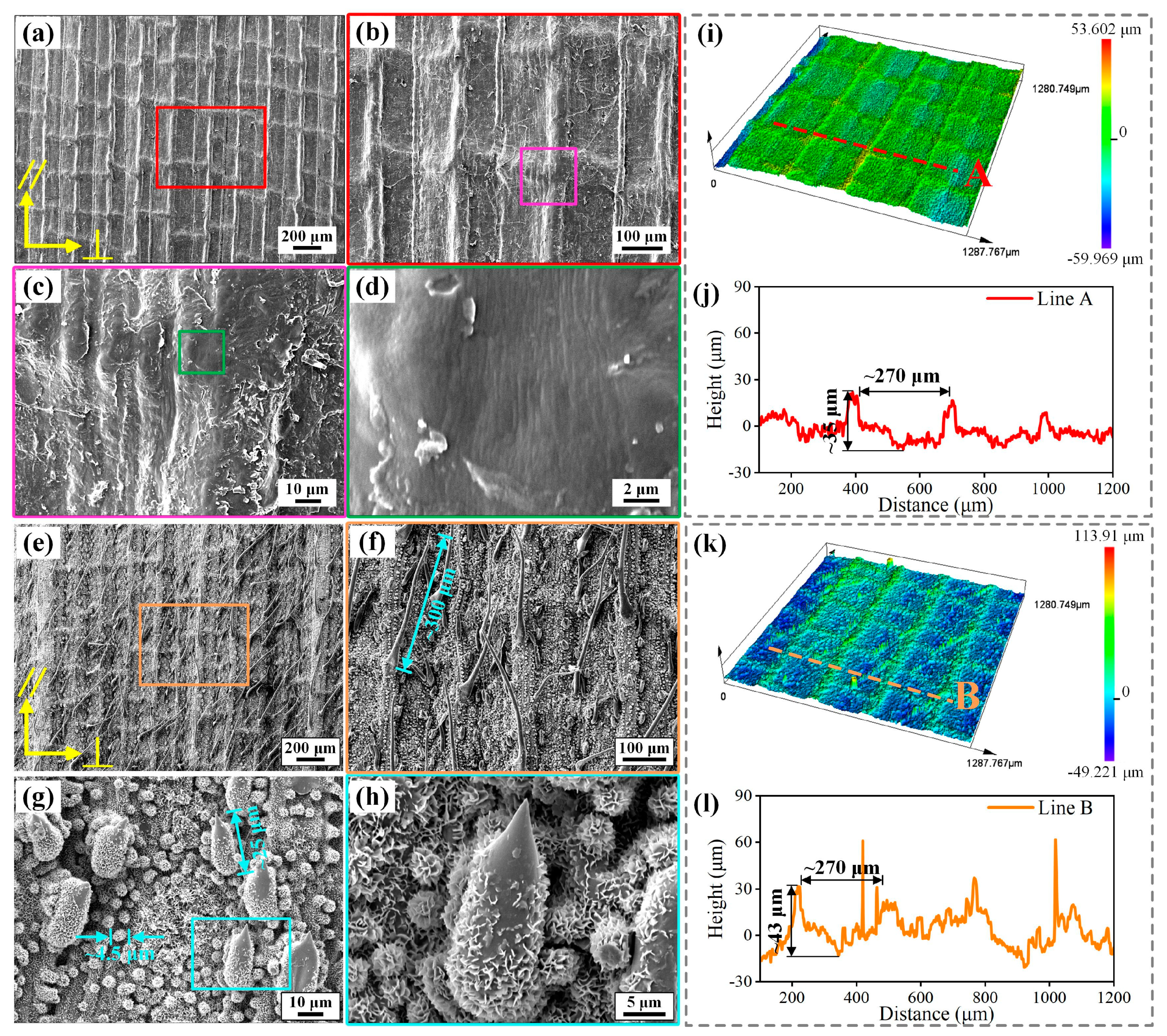
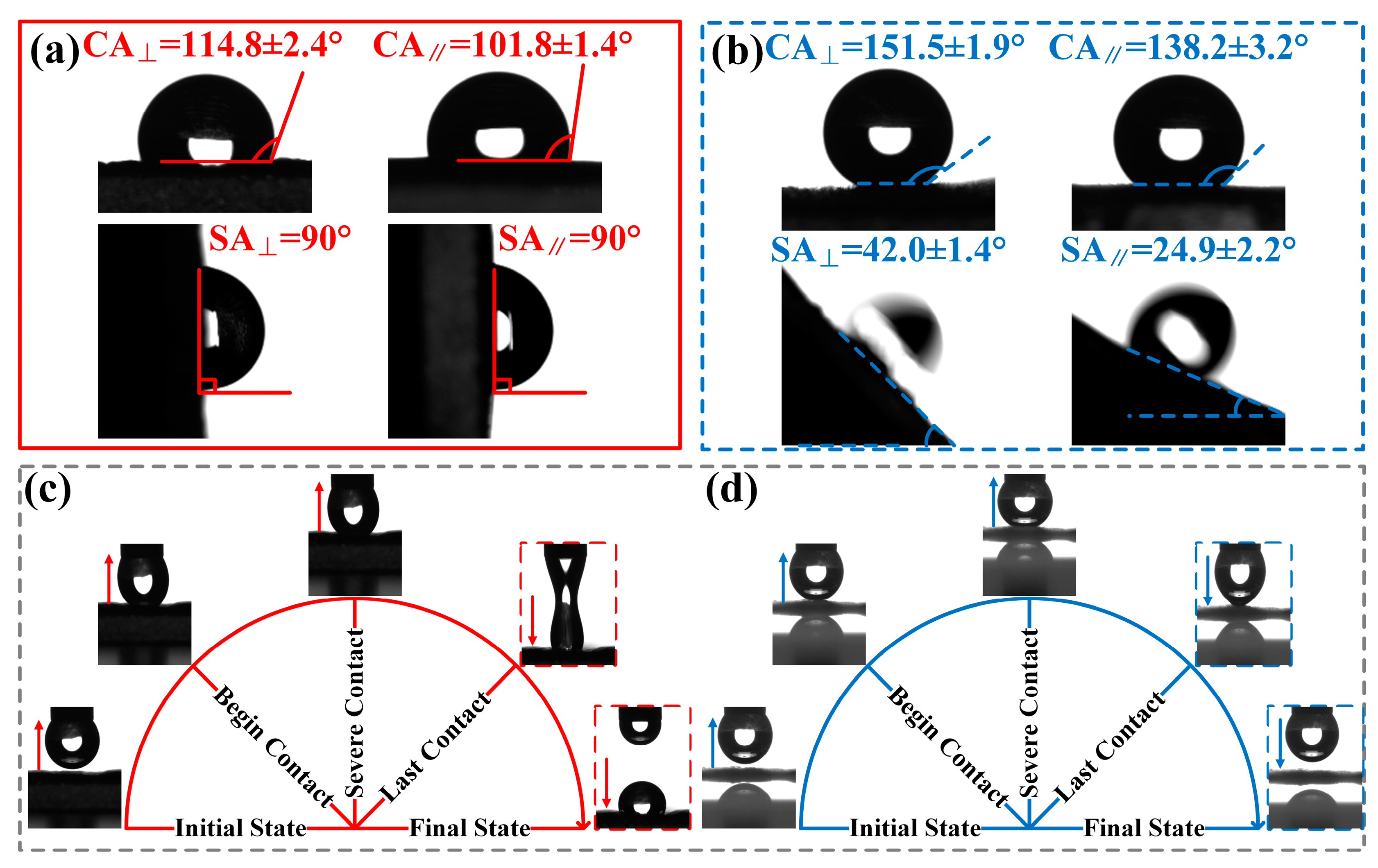
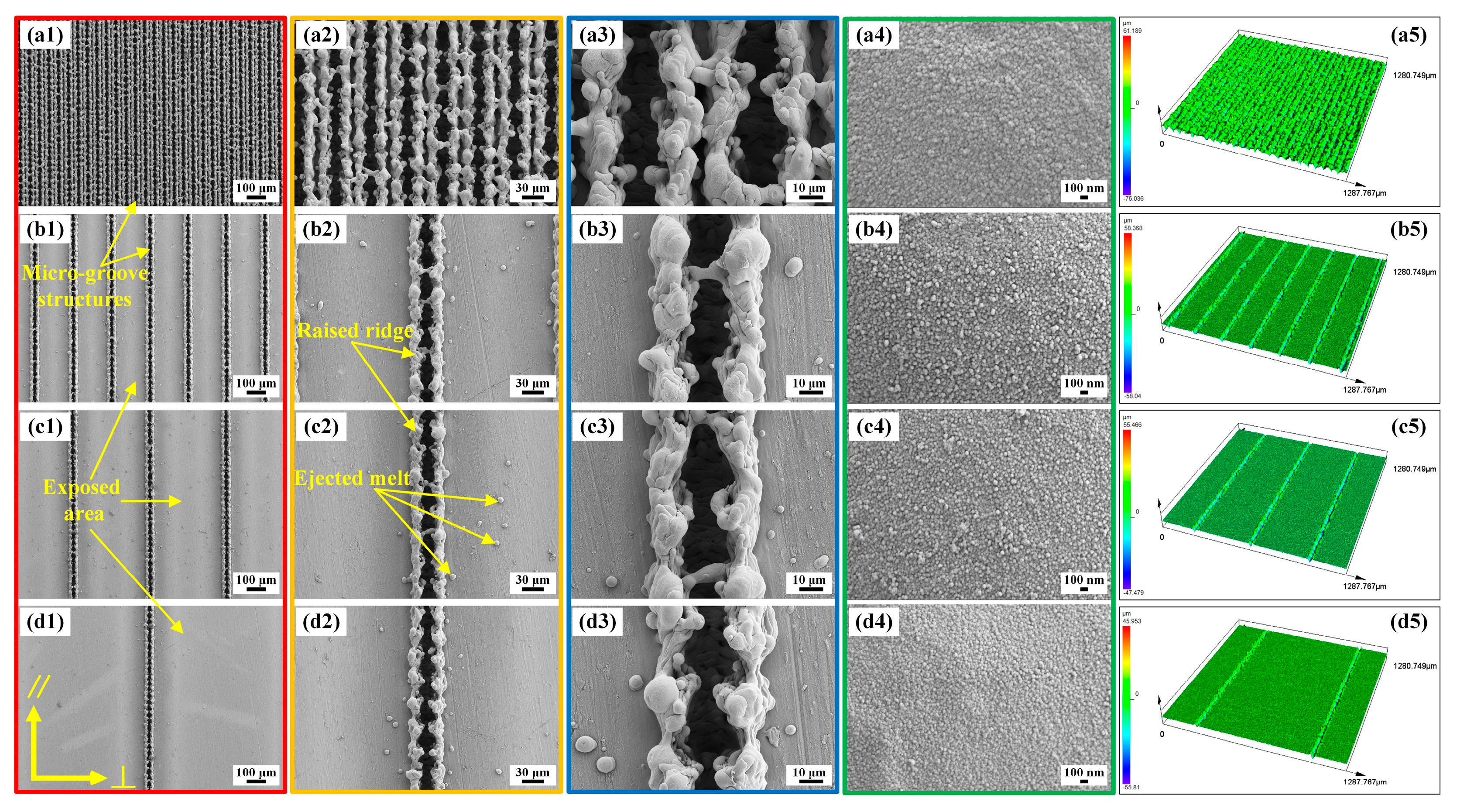



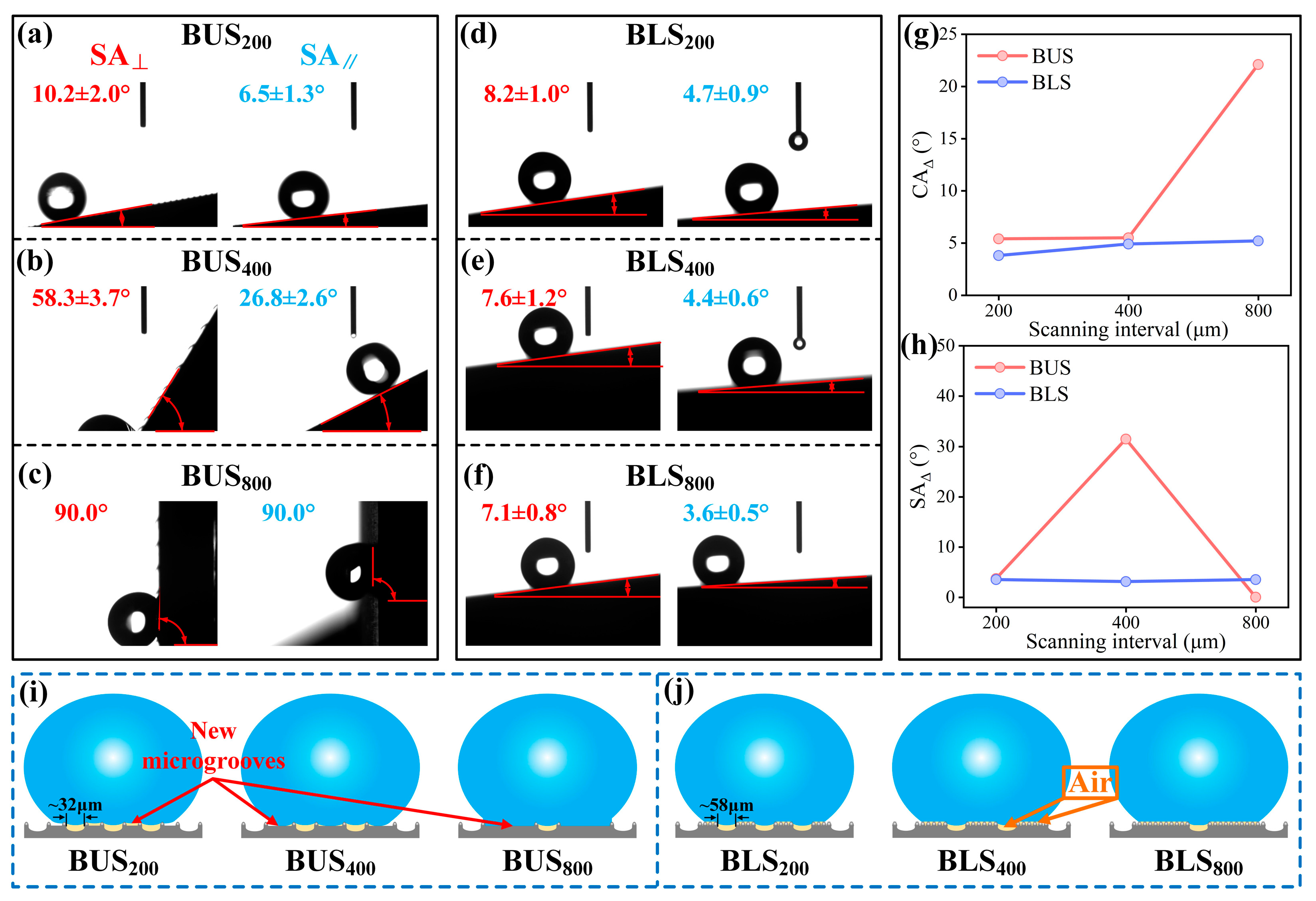
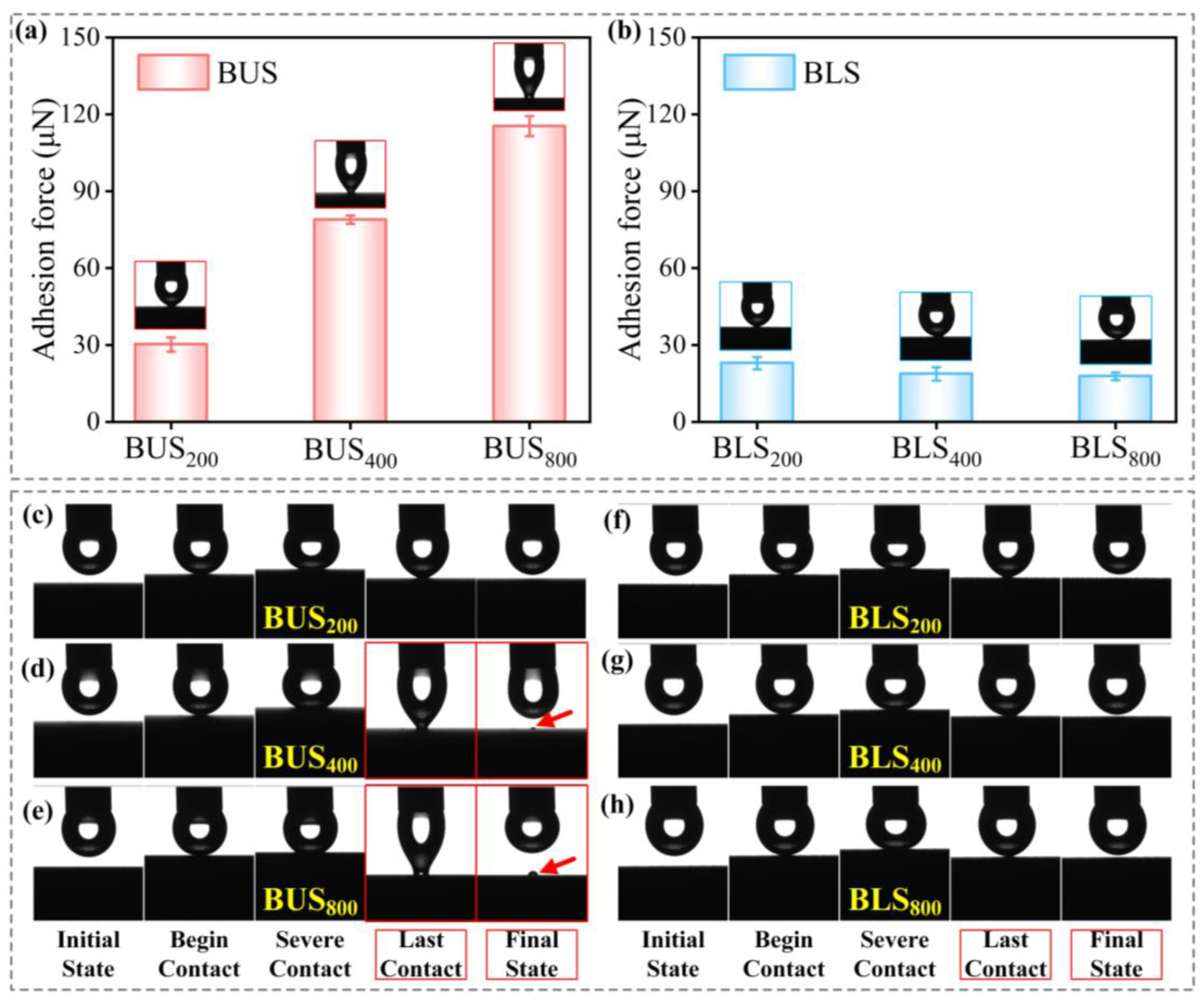
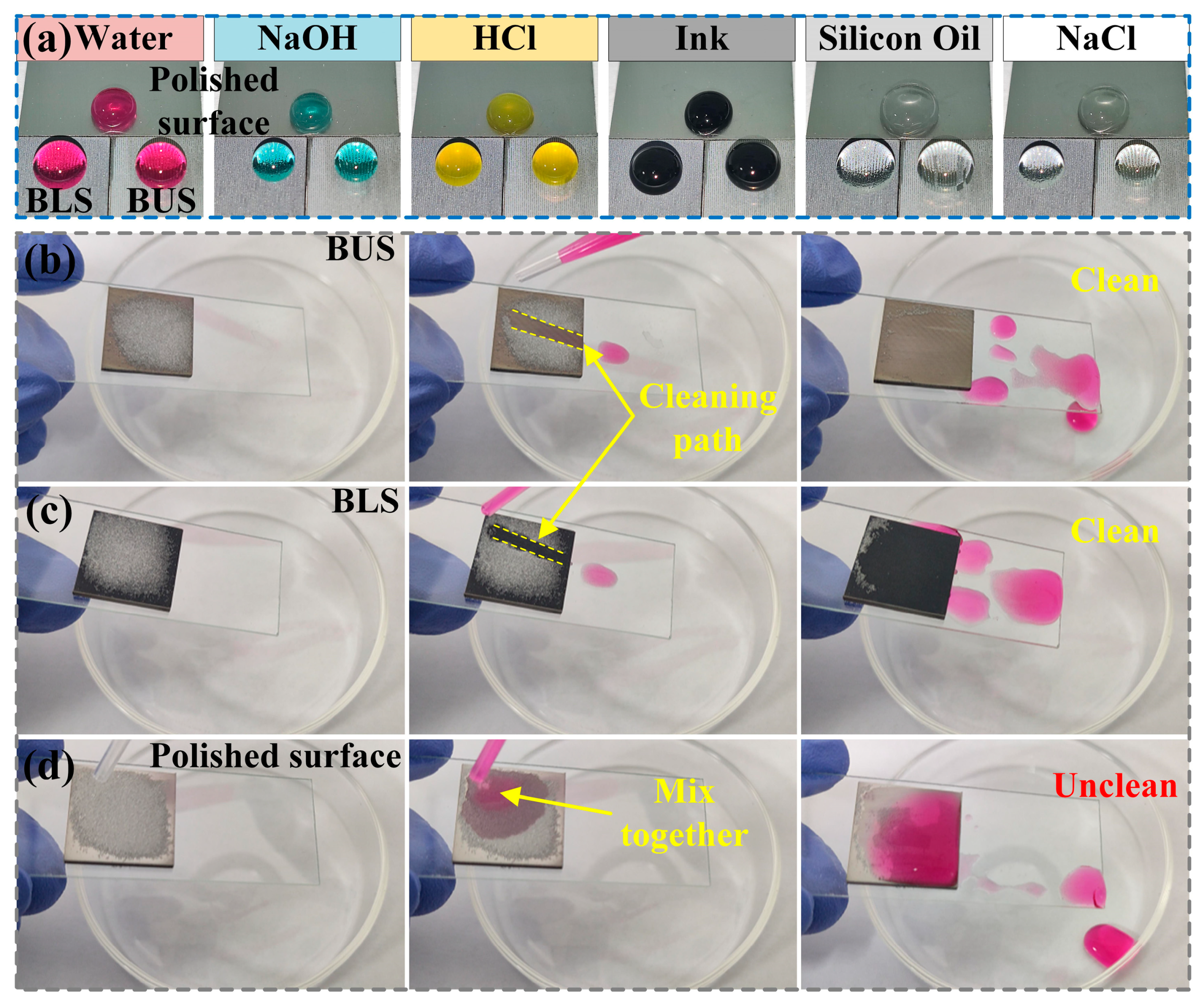
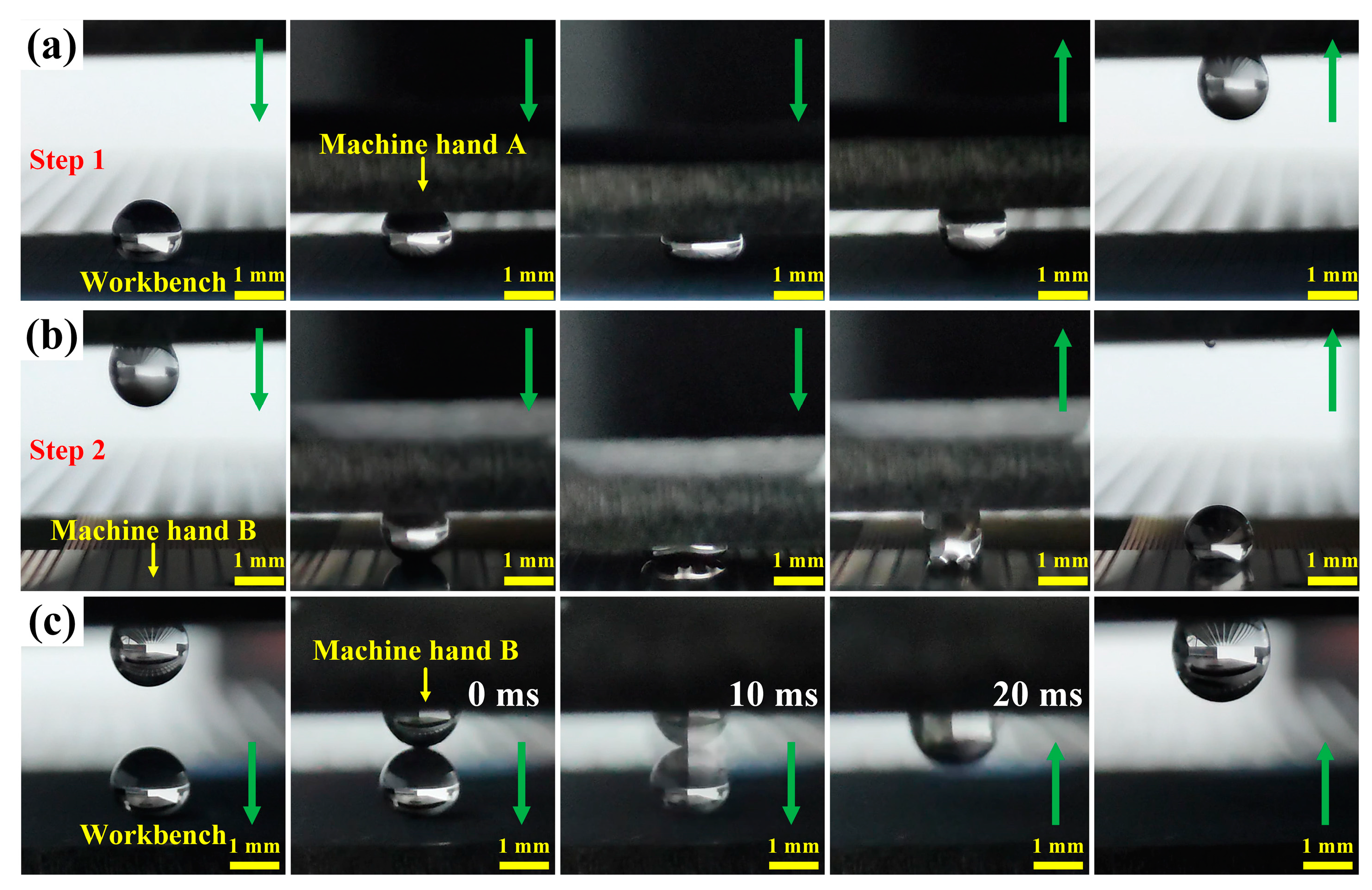
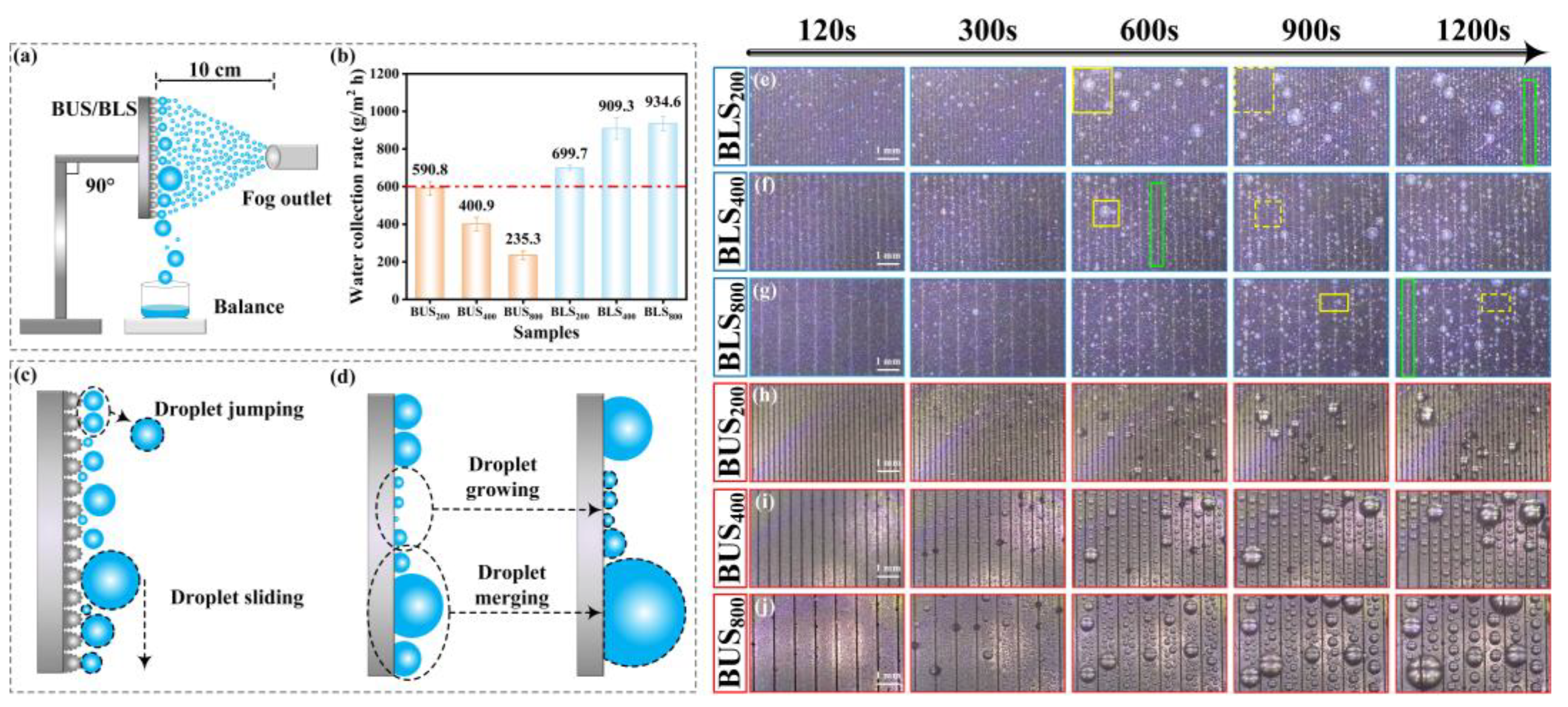
| Surface | Sa (μm) | Sz (μm) | Sq (μm) | Sdr (%) |
|---|---|---|---|---|
| BUS50 | 7.959 | 123.983 | 9.966 | 112.396 |
| BUS200 | 2.383 | 105.888 | 4.394 | 62.631 |
| BUS400 | 1.574 | 93.548 | 3.104 | 51.376 |
| BUS800 | 1.377 | 92.423 | 2.672 | 49.529 |
| BLS50 | 9.223 | 150.201 | 11.103 | 100.988 |
| BLS200 | 5.785 | 152.086 | 7.861 | 85.432 |
| BLS400 | 4.856 | 137.041 | 6.543 | 83.352 |
| BLS800 | 4.889 | 133.516 | 6.562 | 87.281 |
| Bionic Surface/Element | C | O | Ti | Al | V | F | Si |
|---|---|---|---|---|---|---|---|
| BUS200 | 2.19 | 12.90 | 77.03 | 4.28 | 3.60 | - | - |
| BUS400 | 2.50 | 12.72 | 77.07 | 4.30 | 3.41 | - | - |
| BUS800 | 2.76 | 12.89 | 76.72 | 4.26 | 3.37 | - | - |
| BUS200 after modification | 4.07 | 10.54 | 64.28 | 3.59 | 3.01 | 13.93 | 0.58 |
| BUS400 after modification | 3.58 | 9.99 | 66.94 | 3.71 | 3.15 | 12.10 | 0.53 |
| BUS800 after modification | 3.72 | 10.38 | 66.00 | 3.58 | 3.04 | 12.78 | 0.50 |
| BLS200 | 1.49 | 29.25 | 63.00 | 2.92 | 3.35 | - | - |
| BLS400 | 1.38 | 29.38 | 63.01 | 2.88 | 3.34 | - | - |
| BLS800 | 1.68 | 29.22 | 62.90 | 2.91 | 3.28 | - | - |
| BLS200 after modification | 3.13 | 24.76 | 55.84 | 2.60 | 2.77 | 10.21 | 0.68 |
| BLS400 after modification | 2.99 | 24.98 | 56.56 | 2.58 | 3.01 | 9.45 | 0.42 |
| BLS800 after modification | 3.01 | 25.00 | 57.66 | 2.43 | 3.05 | 8.44 | 0.41 |
| Surface | BUS200 | BUS400 | BUS800 | BLS200 | BLS400 | BLS800 |
|---|---|---|---|---|---|---|
| CA⊥ | 165.2° | 155.7° | 151.4° | 167.8° | 168.7° | 168.5° |
| fs | 4.5% | 12.1% | 16.6% | 3.1% | 2.6% | 2.7% |
| CA‖ | 159.8° | 150.3° | 129.3° | 164.0° | 163.8° | 163.3° |
| fs | 8.4% | 17.9% | 49.9% | 5.3% | 5.4% | 5.7% |
| Laser Processing Parameter | BUS | BLS | |
|---|---|---|---|
| One-Step Scanning | First Scanning | Second Scanning | |
| Frequency (kHz) | 20 | 20 | |
| Pulse width (ns) | 100 | 100 | |
| Laser beam wavelength (nm) | 1064 | 1064 | |
| Laser spot diameter (μm) | 50 | 50 | |
| Power (W) | 3 | 3 | 3 |
| Scanning interval (μm) | 50, 200, 400, 800 | 3 | 50, 200, 400, 800 |
| Scanning speed (mm/s) | 200 | 200 | 100 |
| Number of scans | 2 | 2 | 2 |
Disclaimer/Publisher’s Note: The statements, opinions and data contained in all publications are solely those of the individual author(s) and contributor(s) and not of MDPI and/or the editor(s). MDPI and/or the editor(s) disclaim responsibility for any injury to people or property resulting from any ideas, methods, instructions or products referred to in the content. |
© 2024 by the authors. Licensee MDPI, Basel, Switzerland. This article is an open access article distributed under the terms and conditions of the Creative Commons Attribution (CC BY) license (https://creativecommons.org/licenses/by/4.0/).
Share and Cite
Wang, B.; Chen, D.; Yang, X.; Li, M. Investigation and Analysis of Wettability, Anisotropy, and Adhesion in Bionic Upper and Lower Surfaces Inspired by Indocalamus Leaves. Molecules 2024, 29, 3449. https://doi.org/10.3390/molecules29153449
Wang B, Chen D, Yang X, Li M. Investigation and Analysis of Wettability, Anisotropy, and Adhesion in Bionic Upper and Lower Surfaces Inspired by Indocalamus Leaves. Molecules. 2024; 29(15):3449. https://doi.org/10.3390/molecules29153449
Chicago/Turabian StyleWang, Bo, Donghui Chen, Xiao Yang, and Ming Li. 2024. "Investigation and Analysis of Wettability, Anisotropy, and Adhesion in Bionic Upper and Lower Surfaces Inspired by Indocalamus Leaves" Molecules 29, no. 15: 3449. https://doi.org/10.3390/molecules29153449




